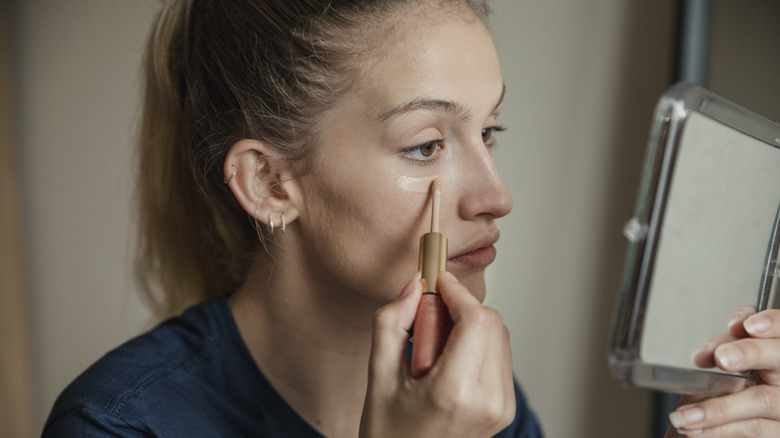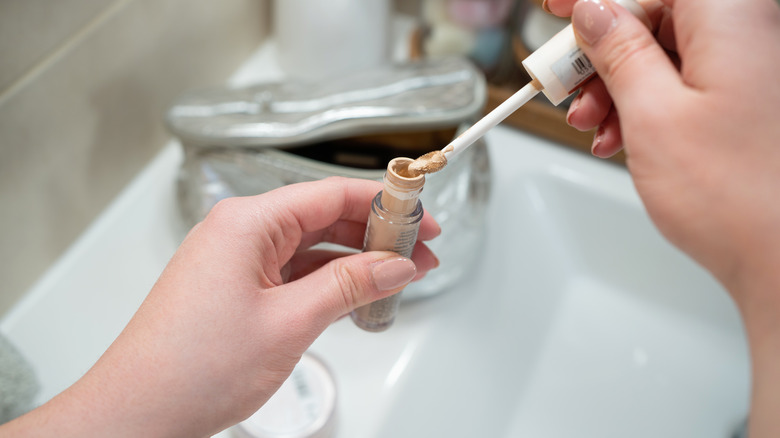Are You Applying Concealer With The Product's Applicator? You Might Want To Reconsider
The liquid concealer you use to cover up inflamed pimples and unwanted dark circles can only work its magic with the help of an applicator. However, if you rely on the sponge or doe-foot applicator wand that comes with the product, you could be inadvertently sabotaging your makeup look.
Scott Barnes, a celebrity makeup artist who's worked with many A-list clients, shared his preferred tool with USA Today Reviewed: "For the best control and smoothest application, I prefer to use brushes for applying everything, including foundation and concealer." Barnes added that brushes come in handy both for the "initial application and blending."
So, what's so wrong with using the applicator included in your concealer tube? The spongy wands tend to pick up too much product, leaving you with a glob of liquid that's likely to turn cakey later. As Los Angeles-based celebrity makeup artist Kelsey Deenihan told Makeup.com, "Applying too much concealer is the number-one culprit of creasing; your skin simply can't handle the amount of product." Sure, the built-in applicator is convenient in a pinch, but it might be defeating the seamless finish you're chasing.
Your applicator wand is probably covered in bacteria
Heavy, creasy makeup is bad enough, but if that doesn't convince you to ditch your concealer's applicator, the bacteria breeding on it might. A 2019 study published in the Journal of Applied Microbiology tested several used cosmetic products, from blending sponges to mascaras, and discovered that 70% to 90% of the items were contaminated with potentially harmful bacteria. Notably, Staphylococcus aureus, E. coli, and Citrobacter freundii were found on the beauty products.
While the study didn't specifically focus on concealer stick applicators, it's safe to assume that they're just as unsanitary. In fact, dermatologist Dr. Shilpi Khetarpal told the Cleveland Clinic that concealer products requiring direct contact with the skin (such as applicators that go back in the tube after use) are among the riskiest types. "When you pump something out of the bottle, you're not contaminating it every time you use it," Dr. Khetarpal explained. "But when you touch your makeup, then your skin, then the makeup again, you're adding bacteria to the product."
What to use instead
We know that makeup brushes are great alternatives, and makeup guru Scott Barnes isn't the only one who recommends them over other applicators. Mandie Brice, a makeup artist in Los Angeles, told Insider that she uses different brushes to apply and blend concealer, depending on what needs covering up. "For under eyes, I like to use a synthetic and fluffy brush, because it ensures that there isn't too much product buildup, which can crease," she explained. "When precision is necessary, like in the cases of a blemish, [using concealer] after foundation and with a small brush is best."
If your brush doesn't deliver enough pigment, remember to practice a bit of layering patience. "I like to work in thin layers to achieve a realistic finish and only apply as much as needed," Suzy Gerstein, a Manhattan-based celebrity makeup artist, revealed to Byrdie. The process might require more time, but you'll notice the payoff when your concealer still looks smooth hours later.
Keep in mind that your brush shouldn't be dipped directly into your concealer the way your applicator would be. To prevent contamination, dab your clean brush on the sponge applicator, and then apply it to the skin. Once used, limit the brush's contact with the applicator to prevent the transfer of oil and microbes. To keep bacteria under control, the American Academy of Dermatology Association recommends cleaning makeup brushes at least once "every seven to 10 days."


